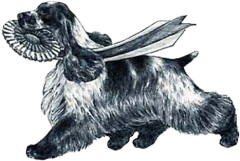Exercise Induced Collapse (EIC)
last updated 24/1/2025
Retriever Type*
Exercise-induced collapse (EIC) is is a nervous system disorder characterized by muscle weakness, lack of coordination, and collapse after intense exercise in otherwise apparently healthy dogs.
Affected dogs tolerate mild to moderate activity but will display signs of EIC after 5-20 minutes of strenuous exercise. The severity of EIC varies. EIC episodes last from 5-25 minutes with a gradual return to normal with no apparent residual weakness or stiffness.
Weakness starts in the rear limbs but then progresses rapidly to the forelimbs, resulting in a generally weak, wobbly gait. Dogs ultimately collapse and are unable to continue exercising. After 10 to 20 minutes of rest, however, they return to normal.
A few affected dogs have died during exercise or while resting after an episode of exercise-induced collapse. Affected dogs are less likely to collapse while swimming than when being exercised on land. Actual ambient temperature does not seem to be a critical factor contributing to collapse, but if the temperature is much warmer than what the dog is accustomed to, collapse may be more likely.
Symptomatic dogs are rarely able to continue training or competition. It seems that if affected dogs are removed from training and not exercised excessively the condition will not progress and they will be fine as pets. Littermates and other related dogs are often affected, but the genetics of the condition have not been well established.
The first clinical symptom observed is usually a rocking or forced gait. The rear limbs then become weak and unable to support weight. Many affected dogs will continue to run while dragging their back legs. Some of the dogs appear to be incoordinate, especially in the rear limbs, with a wide-based, long, loose stride rather than the short, stiff strides typically associated with muscle weakness. In some dogs the rear limb collapse progresses to forelimb weakness and occasionally to a total inability to move. Some dogs appear to have a loss of balance and may fall over, particularly as they recover from complete collapse. Most collapsed dogs are totally conscious and alert, still trying to run and retrieve but as many as 25% of affected dogs will appear stunned or disoriented during the episode.
Reading
Cocker Spaniels are not on the "At Risk" list for EIC
A few commercial laboratories are including this test as part of their package deals, including Orivet which is used by many NZ & Australian breeders.
Mis-information can be worse than no information
To date use of this test has reported no of cocker spaniel carriers or affected with this disease i.e. 100% have returned clear
eIC Around The World
Genetic testing has proven to be a invaluable tool and an intrinsic part of breeding healthy cockers and reducing the likelihood of disease.... IF its the right test, I'm not sure this is.
Informal collection from, OFA database
last updated January 2024
informal data collected from CSDB
Data lasted updated January 2025
% are more important when considering these statistics rather than the numbers recorded above, as some dogs results may have been duplicated in different databases
Research Notes on EIC
This is not an appropriate mandatory test, until the disease is identified in cocker spaniels.
If that happens then the gene and mode of inheritance would still need to be identified. discovered is definitively agreed upon.
Including test that are not identified as relevant or specific to cocker spaniels could be dangerous when breeding make assumptions from these results.
Note Orivet now includes this test as part of their full breed panel, so further information is being gathered which should prove a much better idea of its occurrence within the breed. However they do not publish their statistics, so we're still reliant on self reporting via CSDB and others.
Until that happens I will undertake the testing but be cautious with the results, until further objective data analysis defines the mode of inheritance by scientists.
There is a link below regarding my experience with using tests that are not fully proven or peer reviewed.

